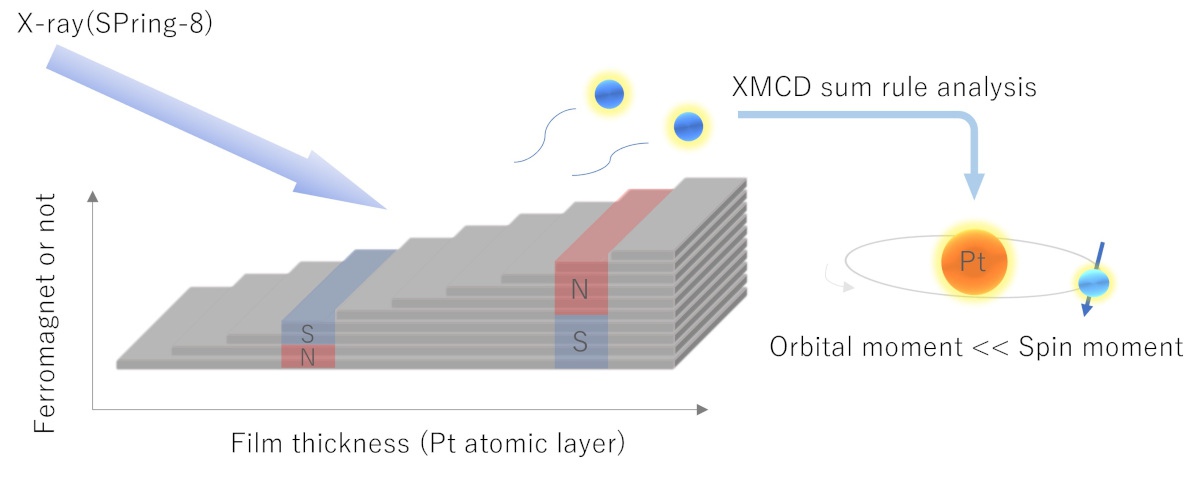Thickness-Dependent Oscillation Behavior of Magnetic Phase Transitions in Pt Ultrathin Films with Small Orbital Moment
© The Physical Society of Japan
This article is on
Appearance of Ferromagnetism in Pt(100) Ultrathin Films Originated from Quantum-well States
(JPSJ Editors' Choice)
J. Phys. Soc. Jpn. 91, 124708 (2022).
Ferromagnetism in nano-Pt films originates from the quantum-confinement effect that depends on film thickness. Studies of the electronic states of nano-Pt will aid in developing methods for efficiently utilizing its large spin-orbit coupling.

Spintronics, the next generation of electronics which utilizes the spin degrees of freedom, is being actively studied in recent years for developing new devices with novel properties. Pt has been an important material in this field since its inception owing to its large spin-orbit coupling.
In terms of the magnetic properties, bulk Pt is paramagnetic whereas Pt nanoparticles exhibit ferromagnetism that originates from the "finite size effect". The detailed mechanism for the appearance of ferromagnetism in Pt nanoparticles is unclear because of complex particle shapes. Thus, the electronic state of nano-Pt is non-trivial, and precise experimental studies for revealing its electronic/magnetic states using high quality nano-Pt is expected to provide important insights for developing nano-spintronic materials.
In this study, we demonstrated the successful preparation of high-quality Pt single-crystal ultrathin films and appearance of ferromagnetism in Pt ultrathin films. Magnetization measurements and density functional theory calculations indicated that ferromagnetism appeared depending on the thickness of Pt with oscillatory behavior. This suggested that the ferromagnetism of nano-Pt originated from quantum-confinement effects.
High-quality ferromagnetic Pt ultrathin films facilitate the analysis of precise electronic and magnetic properties. We investigated the spin/orbital moment of ferromagnetic Pt ultrathin films by utilizing synchrotron X-ray magnetic circular dichroism measurements at the SPring-8 beamline BL39XU. The resultant orbital magnetic moment of pure nano-Pt with large spin-orbit coupling was found to be small like that of Fe.
The present results suggested that to effectively utilize the spin-orbit coupling of Pt effectively, it is necessary to adjust the shape of its wavefunction and enhance its orbital magnetic moment by forming interfaces with other materials (namely, controlling the boundary conditions in nanostructures) and/or by applying external fields. Thus, they provide important insights into the reconsideration of the role of Pt in spintronics research.
The development of materials with well-understood physics, such as the present Pt ultrathin films, is essential for developing a principle-based R&D approach and provides fundamental information for devices. Research and development of multilayer spintronic devices is expected to be further promoted from the perspective of electronic structure based on Pt ultrathin films with well-defined electronic and magnetic states.
(Written by S. Sakuragi, MRI Research Associates, Inc., on behalf of all authors)
Appearance of Ferromagnetism in Pt(100) Ultrathin Films Originated from Quantum-well States
(JPSJ Editors' Choice)
J. Phys. Soc. Jpn. 91, 124708 (2022).
Share this topic
Fields
Related Articles
-
Antiferromagnetism Induces Dissipationless Transverse Conductivity
Electronic transport in condensed matter
Magnetic properties in condensed matter
Electronic structure and electrical properties of surfaces and nanostructures
2024-7-24
An investigation using high-quality NbMnP crystals demonstrates that the anomalous Hall conductivity arising from antiferromagnetism is dissipationless, as expected from the intrinsic mechanism.
-
Structural Rotation and Falsely Chiral Antiferromagnetism: A New Combination Generating Ferrotoroidic State
Magnetic properties in condensed matter
Dielectric, optical, and other properties in condensed matter
2024-7-4
The ferrotoroidic state, an exotic state of matter with broken space inversion and time-reversal symmetries, was achieved by combining structural rotation and falsely chiral antiferromagnetism in PbMn2Ni6Te3O18.
-
Understanding Electronic Ordering and Cross Correlations with Multipole Representation
Magnetic properties in condensed matter
2024-6-12
This study reviews the recent advancements in research of multipole representations for understanding electronic orderings and cross-correlations in materials and presents future research directions.
-
Microscopic Exploration of Electronic States in Nickelate Superconductors
Magnetic properties in condensed matter
Superconductivity
2024-5-31
The multilayered nickelates, La3Ni2O7 and La4Ni3O10 , were investigated using nuclear magnetic resonance (NMR) at ambient pressure. Metallic electronic states under the density wave order were observed microscopically for both compounds.
-
Solving a Stochastic Differential Equation is Solving a Mean-Field Quantum Spin System
Statistical physics and thermodynamics
Mathematical methods, classical and quantum physics, relativity, gravitation, numerical simulation, computational modeling
Magnetic properties in condensed matter
2024-5-16
The replica method maps matrix-valued geometric Brownian motion to a mean-field quantum spin system. This correspondence makes it possible to obtain an exact solution for matrix-valued geometric Brownian motion.
